To view a PDF of the report, click here.
1 - INTRODUCTION: Surging Interest
Investors seeking diversification, higher yields, cash flow and risk hedges are increasing their allocations to real assets.
By Richard Westlund
Gold prices have been rising steadily in 2016, driven by global demand for the precious metal. Institutional investors are snapping up income-producing assets in the infrastructure sector, such as airports, power plants, toll roads and communication towers. Commercial real estate properties that provide cash flows and potential long-term appreciation are attracting new investor commitments as well.
It all adds up to a surging interest in real assets, which typically have low correlations to traditional financial holdings such as stocks and bonds.
“We don’t see gold as a stand-alone asset,” says George Milling-Stanley, head of gold investment strategy at State Street Global Advisors. “Instead, it can play an important role in a properly balanced portfolio, including protection against tail-risk events like geopolitical shocks and currency depreciation.”
Other types of real assets also provide diversification benefits while delivering stable cash flows and creating strategic and tactical return opportunities. Infrastructure investments can be ideal for matching long-term liabilities, according to Jay Rosenberg, managing director and head of investments for real assets at Nuveen Asset Management, a majority-owned affiliate of TIAA Global Asset Management. “We see lower volatility in infrastructure than the broader market,” he says. “There is less cyclicality in supply and demand. There is limited supply, and demand tends to be less elastic than in the broader market.”

| 
| 
| |
| Jay Rosenberg Managing director and head of investments for real assets, Nuveen Asset Management | George Milling-Stanley Head of gold investment strategy, State Street Global Advisors | Marietta Moshiashvili Managing director and sector head of energy & infrastructure, TIAA Global Real Assets | |
| “We see lower volatility in infrastructure than the broader market. There is less cyclicality in supply and demand.” | “We don’t see gold as a stand-alone asset. Instead, it can play an important role in a properly balanced portfolio, including protection against tail-risk events like geopolitical shocks and currency depreciation.” | “We have seen increased allocations to infrastructure through both private and public investment strategies.” |
Gold: Pent-up demand
Low interest rates are prompting a shift in how investors think about the gold market, according to Juan Carlos Artigas, director of investment research at the World Gold Council. “Today investing in fixed-income securities is difficult,” he says. “Many investors have taken on more risk in the search for higher returns. Gold can help hedge those risks, as historically it’s done very well during pullbacks in the financial markets.”
The gold price gained nearly one third between January and August of this year, rising from $1,060 an ounce to $1,336.80, according to the World Gold Council. Artigas notes that several other factors are contributing to the run-up. “There is strong pent-up demand for gold from investors who had reduced their positions, central banks in emerging markets and the consumer and industrial markets,” he says. “We believe a good portion of those inflows are based on strategic considerations, providing some sustainability to gold’s performance.”
Both Artigas and Milling-Stanley point to the impact of the U.S. dollar on the gold market. “When the dollar is strong, gold prices have been weak,” says Milling-Stanley. “While the U.S. dollar is still strong compared with most global currencies, that downward pressure has eased in recent months, largely because the Fed has signaled that it won’t aggressively raise rates.”
Investors have multiple ways to gain exposure to gold. For example, short-term investors might look at tactical trading opportunities or the futures market, says Milling-Stanley. Other investors allocate to mining equities, seeking companies that might outperform the competition or get lucky with their explorations.
“For many investors, exchange-traded funds (ETFs) have been phenomenally successful,” Milling-Stanley says. “They are often the most tax-efficient and cost-effective way to gain exposure to gold through a regulated stock exchange with completely secure transactions.”
The World Gold Council’s research largely indicates that an optimum allocation to gold would be about 5 percent of a typical 60–40 stock–bond investment portfolio, Artigas notes. “This tends to give the best risk-adjusted returns,” he says.
Infrastructure: A hedge with cash flows
One of the benefits of infrastructure is that these income-producing assets can provide a hedge against both inflation and deflation. In inflationary periods both cash flow and the cost to reconstruct the asset typically increase, says Rosenberg. On the other hand, continuing low discount rates from central banks lift the value of assets that generate stable, long-term cash flows.
“We have seen increased allocations to infrastructure through both private and public investment strategies,” says Marietta Moshiashvili, managing director and sector head of energy & infrastructure at TIAA Global Real Assets.
Direct investment in infrastructure assets offers the potential for better governance and value creation through active management of the assets, says Moshiashvili. “You can build a customized private portfolio of location- and sector-specific assets through direct board influence or control to advance the overall direction, growth and capital structure of the businesses.”
Rosenberg notes that public and private ownership strategies can complement each other, providing different return and volatility profiles. “A listed strategy can mitigate some of the regulatory, political and natural-disaster risks to these assets,” he says. “That’s because you typically hold shares of a diverse collection of assets, which spreads those types of risks.”
A listed strategy also offers investors real-time liquidity for repositioning a portfolio, he adds: “Another reason to consider a listed strategy is access to mission-critical assets. Governments that sell stakes in these assets may want to encourage local ownership through listing. This results in many of these types of assets being available in the listed marketplace.”
Many institutional investors with diversified portfolios are attracted to an active management strategy, seeking out value in different sectors and locations. “That’s important, since the fundamentals that drive revenue growth, asset value and overall returns can vary at different points of the market cycle,” Rosenberg says. “Investors can also take advantage of varying government regulations and monetary policy in different parts of the world.”
Both Moshiashvili and Rosenberg emphasize the importance of having an experienced management team in place to operate these assets and increase their value. “Along with a deep understanding of local regulatory and economic risks, you need operational expertise to drive the asset’s value and optimize risk-based returns,” says Moshiashvili.
Commercial real estate: U.S. and global strategies
As one of the most mature real asset classes, real estate offers an almost unlimited number of investment possibilities, including direct ownership, shares in private or publicly traded real estate investment trusts (REITs) and debt securities such as mortgages or mezzanine loans. Investors can also focus on specific property types, such as office, industrial, retail, multifamily, hospitality or self-storage facilities, or diversify geographically across the U.S. or globally. Indeed, commercial real estate is becoming a decidedly cross-border business: International investment activity rose 24 percent in 2015 over the previous year as global investors continued to move more capital across borders, according to Cushman & Wakefield.
“Many domestic and international investors today have a sophisticated understanding of the U.S. markets,” says Sant’Albano. “They may invest in the major metropolitan markets early in a real estate cycle and then allocate to secondary markets as property prices rise.”
Office vacancy rates are falling in major markets: Atlanta saw a drop from 17.2 percent to 16 percent in the year ended in June 2016, while in Washington the vacancy rate declined from 18 percent to 17.9 percent. The influx of capital from European, Asian and Latin American investors continues to compress yields, particularly for core assets such as modern Class A office buildings. “In an effort to hit their return targets, some investors are allocating to different classes, like retail and multifamily, or considering development opportunities,” says Sant’Albano.
Globally, investor interest has shifted from offices, where investment fell 2.2 percent in 2015, to three rising subsectors: apartments (up 27 percent), hotels (up 26 percent) and industrial properties (up 10 percent).
Investors should also pay attention to structural shifts in the use of commercial properties, such as more flexible office environments and greater demand for distribution facilities from online retailers, Sant’Albano cautions. In addition, corporate tenants are demanding a higher level of building services and energy-saving systems.
“Investors need to understand how to apply their capital to the evolving commercial real estate market,” says Sant’Albano. “Finding the right local partner aligned with the investors’ interests can be a critical component of that capital deployment strategy.”
2 - WHY INSTITUTIONS ARE EYEING INFRASTRUCTURE
In recent years institutional investors have increased allocations to infrastructure assets, through private and public investments, as a diversification tool to reduce portfolio volatility and hedge against both inflation and deflation. TIAA Global Asset Management’s Marietta Moshiashvili, sector head of private infrastructure, and Jay Rosenberg, head of investments for real assets at Nuveen Asset Management, discuss the role infrastructure can play as investor expectations for returns from other asset classes continue to diminish.
Definitions of infrastructure vary widely. How do you define this asset class?
Rosenberg: We think of infrastructure as location-specific assets that garner a fee for their use. So we’re talking about assets employed in the movement or transmission of people, energy or communications and the provision of essential services. Importantly, we like to see the fees on infrastructure assets paid through long-term concessions or contracts, which provide enhanced visibility into cash flow. We feel a large majority of the company’s value should be derived from regulated, contractual or concessionary cash flows.
Moshiashvili: We define infrastructure assets as having specific characteristics that include providing essential services for the economy or community; having high barriers to entry and monopolistic qualities as a result of their contractual or regulatory regimes; and benefiting from stable and inflation-linked cash flows over the long term.
We differentiate further by qualifying the assets as core or core-plus, which includes certain energy-related infrastructure. Core covers anything that is regulated, contracted or otherwise predetermined. Core-plus covers assets that are moving from the development stage toward the contractual, mature stage, so they offer a better risk—return profile. There is also a differentiation based on geographic location that leads to various political and regulatory risk considerations.
In the past, some institutional investors have shied away from infrastructure because of low return expectations relative to other investment opportunities. Has that dynamic shifted now with expectations for other asset classes declining?
Moshiashvili: There is rising demand for infrastructure assets, driven by improved investor appreciation for the stability, lower volatility and investment performance of the asset class. There’s also an increasingly attractive investment backdrop. You have greater availability of debt and higher valuations for assets, prompting government and strategic players to realize that this is a great time to reduce their ownership stake in mature core assets in well-developed markets. As such, we are seeing an increasing number of attractive secondary and emerging opportunities in the market.
Rosenberg: Clearly, infrastructure has been made more attractive as falling interest rates have depressed overall required rates of return. A lot of that has to do with the fact that infrastructure as a whole typically displays lower volatility than the broader market. Infrastructure assets, with relatively stable cash flows and greater longer-term visibility, are typically in a good place in this low-return, subdued-growth environment, especially when compared with less predictable and more volatile earnings in other segments of the economy.
Infrastructure investing can also provide the opportunity to get higher growth if you’re willing to stomach higher volatility. There are certain segments of the asset class that have enjoyed tremendous historical growth and volatility, such as energy midstream plays in North America and infrastructure buildouts in emerging markets. The growth and volatility attributes of those assets either match or exceed those of many growth companies out there.
Infrastructure has often been viewed as a hedge against inflation. Doesn’t that make it less appealing in the kind of low-growth, low-inflationary period we find ourselves in now?
Rosenberg: Infrastructure has attributes that make it both an inflation hedge and a deflation hedge. On the asset side, when inflation rises, the replacement cost of these assets naturally rises with the price of labor and materials. On the cash flow side, many infrastructure assets enjoy automatic inflation pass-through in their regulated structure or they have regular rate reviews that allow for periodic changes in the cost of capital. The deflation side is equally if not more important. With suboptimal growth and inflation around the world, you have monetary policies that are providing stimulus, which keeps discount rates low. The current environment is especially conducive to lifting the value of the assets with visible cash flows.
Why are institutional investors, generally speaking, well suited for infrastructure investing?
Moshiashvili: The benefits of infrastructure investment have been tested in volatile and uncertain market environments. A separate allocation to infrastructure in a portfolio allows institutional investors to closely match their long-term and sizeable liabilities with the long-term cash flow profile of capital-intensive infrastructure assets. It also contributes diversification benefits, reliable inflation-linked returns and low correlation and volatility when compared with traditional asset classes. The asset’s capital-intensive nature allows investors to put significant investment dollars to work.
Rosenberg: Infrastructure also plays to the advanced capabilities of institutional investors. The valuation of infrastructure assets is very detailed and modeling-intensive, as you have contracts or concessions with varying fixed-ending lives. Traditional multiples such as return on equity and traditional fundamental analysis won’t help given the finite lives of the cash flow streams, which distort fair value. So it takes a level of sophistication to really understand the value proposition of infrastructure, and well-resourced institutional investors tend to be well suited for that.
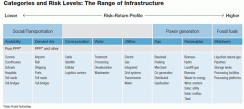
What should you consider when comparing private versus listed infrastructure?
Moshiashvili: Private infrastructure investments can add significant diversification benefits to institutional investors’ portfolios. Investing in unlisted infrastructure represents a customized approach for any investor who wants to have a particular geographic or sectoral concentration, because you have the ability to select an asset. That ability is not always present in the public markets. Exposure to unlisted infrastructure also allows for better governance. Whether you’re a controlling investor or you have negative control provisions as part of a consortium, you have influence over the strategy of the investment, its capital structure and the operating risk associated with it. This lends itself well to those looking to create value through active growth strategies and management of the asset, whether it’s through operational maintenance, improvements or some other means.
Rosenberg: Public and private ownership strategies can be very complementary, providing access to a wide range of assets and return and volatility profiles. The diversification potential of a listed strategy can mitigate some of the regulatory, political and natural-disaster risks to these assets. That’s because you can hold shares of a wide-ranging collection of assets and regions, which dilutes those types of risks. A listed strategy also gives you real-time liquidity, allowing you to reposition your portfolio in an ever-changing environment. In addition, many mission-critical or gateway assets, such as some of the largest seaport assets in China and major airports, including Sydney and Charles de Gaulle, can be found in the listed marketplace.
To what extent have public-private partnerships contributed to the rising popularity of unlisted infrastructure assets?
Moshiashvili: Privatization has certainly played a critical role in the asset class, starting in Europe and Australia and now increasingly in North America. Private foreign investment regimes were instituted as early as the 1990s in the U.K. but took some time to catch on elsewhere. Today there is a potent combination of trends pushing for more privatization of public infrastructure: population growth, constrained government budgets and high levels of public debt. And now it’s finally reached the U.S., where we have seen tremendous growth in public—private structures over the past five years that has pushed private investment beyond the more traditional power assets. You have 33 states and Puerto Rico that are privatizing through their legislative regimes. They invite private capital in for financing or improvements or construction of transportation assets or for operation of some social infrastructure assets, like schools, courthouses and hospitals.
With all of the attention on infrastructure investments, what has that meant for competition for publicly held assets?
Rosenberg: There is significant competition for very high-quality assets. We’re in a period of subdued growth globally, and required rates of return are quite low. This is raising the appeal of very high-quality, highly visible cash flows, particularly in very stable political and regulatory environments. As a result, we’ve also seen substantial M&A interest in those types of assets, such as in the North American regulated utility sector. There has also been significant interest in regulated assets in other stable political and regulatory environments, such as the U.K. and Australia. When these types of assets come up for sale, there tends to be a significant amount of capital chasing them, often coming from the big pension plans and sovereign wealth funds.
What are the trends driving the supply of new infrastructure opportunities?
Moshiashvili: While you do have a lot more players competing in the private infrastructure space, particularly in the well-developed markets where contracts are highly enforceable, there are new trends creating fresh infrastructure opportunities, despite the valuation and competition concerns. You have the basic fact that we need to build out our infrastructure due to population growth. You have scarcity of natural resources, prompting the expansion of our energy infrastructure. You have the urbanization trend contributing to constrained budgets on the public debt side. You also have some disruptive shifts, such as climate change and the regulations being passed that are forcing new modes of energy distribution and measures promoting efficiency. Then there are changing human behaviors, such as people wanting everything delivered to their door, which will have profound implications for shipping infrastructure. These are just a few of the influences that create new market trends and should be considered by institutional investors when evaluating infrastructure.
Rosenberg: Infrastructure assets are diverse. With so many different types of assets and geographic areas, opportunities are still abundant and attractive. Acceptable valuations can still be found, and additional opportunities will surely arise, given the ever-changing commodity markets and political and regulatory environment.
Real asset investments may be subject to environmental and political risks and currency volatility. Investments will be subject to risks generally associated with the ownership of real estate—related assets and foreign investing, including changes in economic conditions, currency values, environmental risks, the cost of and ability to obtain insurance and risks related to leasing of properties.
Diversification is a technique to help reduce risk. There is no guarantee that diversification will protect against a loss of income. The material is for informational purposes only and should not be regarded as a recommendation or an offer to buy or sell any product or service to which this information may relate. Certain products and services may not be available to all entities or persons. Past performance does not guarantee future results.
TIAA Global Asset Management provides investment advice and portfolio management services through TIAA and over a dozen affiliated registered investment advisers.
©2016 Teachers Insurance and Annuity Association of America—College Retirement Equities Fund, 730 Third Avenue, New York, NY 10017 C33691
Contact Information
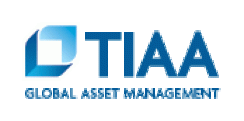
John Panagakis
Head of Global Private Distribution
TIAA Global Asset Management
JPanagakis@tiaa.org

Lynne Harrington
Head of Institutional Sales and Client Service
Nuveen Asset Management
Lynne.Harrington@Nuveen.com
3 - GOLD OUTSHINES THE MARKET
A perfect storm lifts gold
Gold staged an impressive rally in the first half of this year, rising almost 30 percent in U.S. dollar terms — its best performance in almost three decades. The return on gold significantly outperformed other major stock, bond and commodity indexes.
We believe that market uncertainty and expansionary monetary policies will continue to support both investment and central bank demand.
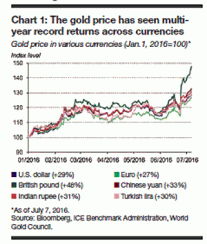
The gold price is up across currencies
Gold’s rally this year constitutes the largest six-month gain the metal has seen since the European sovereign debt crisis in 2010 and 2011. In British pound terms, gold’s rise has been even more dramatic. As sterling has dropped to multidecade low against the dollar, the price of gold has increased by almost 50 percent since the end of 2015 — a performance not seen since Lehman Brothers’ collapse in 2008.
In fact, gold has been one of the best-performing assets over the past year, outpacing most other asset classes and with no more volatility than benchmark equity indexes (see Chart 2, below). It has also outpaced U.S. Treasuries and high-quality corporate bonds.
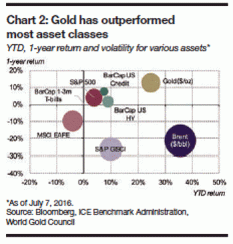
Market uncertainty and expansionary policies support gold
The rally in the gold price is supported by five key factors, in our view:
- Greater market uncertainty. Global macroeconomic conditions have deteriorated, increasing uncertainty and pushing investors to rethink asset allocation. Volatility in emerging markets, Brexit and downgraded growth forecasts have all contributed to this.
- A hiatus in the rise of the U.S. dollar. After consistently strengthening for most of 2014 and 2015, the value of the dollar has softened in 2016, providing a respite for gold.
- Implementation of negative interest rate policies (NIRP) in Europe and Japan. As they grapple with market uncertainty, central banks are signaling an even more accommodative stance. Low interest rates reduce the opportunity cost of holding gold. Negative rates magnify this. NIRP significantly shrinks the likely pool of assets that investors may hold: 37 percent of high-quality sovereign debt is trading with a negative yield (see Chart 3, below)and almost 40 percent more carries yields below 1 percent, including a good portion of U.S. debt. In addition, NIRP erodes confidence in fiat currencies because of the threat of currency wars and monetary interventions and of increased uncertainty and market volatility as central banks run out of effective policy options to combat inflation/deflation and/or spur growth.
- The return of pent-up investment demand for gold. Toward the end of 2015, we saw indications that investors were waiting for a catalyst to get back into the market. Many of the strategic gold investors that had reduced their exposure in previous years appeared to have increased their gold holdings again.
- Price momentum. Some investors, too, are following gold’s upward trend for tactical reasons.
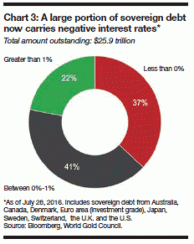
Investment demand has been strong on many fronts
These factors, combined, have led to higher investor demand for gold. Gold-backed ETFs have seen record inflows, adding 579 tons ($22.6 billion) in the first half of 2016 to bring their collective global holdings to 2,200 tons — a substantial increase, but still 25 percent below their 2012 high (see Chart 4 below). Similarly, bar and coin investors in some developed markets have made significant purchases. The U.S. Mint reports an 84 percent increase in sales of American Eagles during the first half of 2016 compared with the same period last year. Additionally, the U.K. Royal Mint saw spikes in sales before and after Brexit.
Interest rates continue to be pushed down further, structurally altering gold demand
The current market environment has pushed bond yields even lower. By the end of July, the ten-year German Bund was trading at –0.12 percent, the Japanese government bond at –0.2 percent and the U.S. Treasury bond at 1.45 percent — close to its lowest level since the 1930s — prompting investors to add more risk to their portfolios. There have been heavy capital inflows into equities and high-yield bonds despite a bleaker macro picture and expensive valuations.
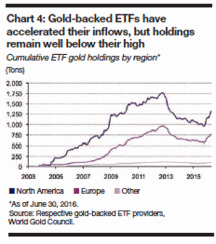
All of this points to a positive outlook for gold. A historical analysis shows that when real rates are negative, gold returns tend to be twice as high as the long-term average.
Low opportunity costs of investing in gold, combined with its strong performance, will likely result in further inflows. In fact, we believe that over the long run NIRP will lead to structurally higher demand for gold from central banks and investors alike.
About the World Gold Council
The World Gold Council is the market development organization for the gold industry. Our purpose is to stimulate and sustain demand for gold, provide industry leadership and be the global authority on the gold market.
We develop gold-backed solutions, services and products based on authoritative market insight and work with a range of partners to put our ideas into action. As a result, we create structural shifts in demand for gold across key market sectors. We provide insights into the international gold markets, helping investors to understand the wealth preservation qualities of gold and its role in meeting the social and environmental needs of society.
Based in the U.K., with operations in India, the Far East and the U.S., the World Gold Council is an association whose members comprise the world’s leading gold mining companies
Copyright and other rights
© 2016 World Gold Council. All rights reserved. World Gold Council and the Circle device are trademarks of the World Gold Council or its affiliates.
All references to LBMA Gold Price have been provided for informational purposes only. ICE Benchmark Administration Limited accepts no liability or responsibility for the accuracy of the prices or the underlying product to which the prices may be referenced.
Other third-party data and content is the intellectual property of the respective third parties and all rights are reserved to them.
Any copying, republication or redistribution of content to reproduce, distribute or otherwise use the statistics and information in this report, including by framing or similar means, is expressly prohibited without the prior written consent of the World Gold Council or the appropriate copyright owners, except as provided below.
The use of the statistics in this report is permitted for the purposes of review and commentary (including media commentary) in line with fair industry practice, subject to the following two preconditions: (i) only limited extracts of data or analysis be used; and (ii) any and all use of these statistics is accompanied by a clear acknowledgment of the World Gold Council and, where appropriate, of Thomson Reuters, as their source. Brief extracts from the analysis, commentary and other World Gold Council material are permitted, provided World Gold Council is cited as the source. It is not permitted to reproduce, distribute or otherwise use the whole or a substantial part of this report or the statistics contained within it.
While every effort has been made to ensure the accuracy of the information in this document, the World Gold Council does not warrant or guarantee the accuracy, completeness or reliability of this information. The World Gold Council does not accept responsibility for any losses or damages arising directly or indirectly from the use of this document.
The material contained in this document is provided solely for general information and educational purposes and is not, and should not be construed as, an offer to buy or sell, or as a solicitation of an offer to buy or sell, gold, any gold-related products or any other products, securities or investments. Nothing in this document should be taken as making any recommendations or providing any investment or other advice with respect to the purchase, sale or other disposition of gold, any gold-related products or any other products, securities or investments, including without limitation any advice to the effect that any gold-related transaction is appropriate for any investment objective or financial situation of a prospective investor. A decision to invest in gold, any gold-related products or any other products, securities or investments should not be made in reliance on any of the statements in this document. Before making any investment decision, prospective investors should seek advice from their own financial advisers, take into account their individual financial needs and circumstances and carefully consider the risks associated with such investment decision.
Without limiting any of the foregoing, in no event will the World Gold Council or any of its affiliates be liable for any decision made or action taken in reliance on the information in this document — and, in any event, the World Gold Council and its affiliates shall not be liable for any consequential, special, punitive, incidental, indirect or similar damages arising from, related to or connected with this document, even if notified of the possibility of such damages.
This document contains forward-looking statements. The use of the words “believes,” “expects,” “may” or “suggests,” or similar terminology, identifies a statement as “forward-looking.” The forward-looking statements included in this document are based on current expectations that involve a number of risks and uncertainties. These forward-looking statements are based on the World Gold Council’s analysis of the statistics available to it. Assumptions relating to these forward-looking statements involve judgments with respect to, among other things, future economic, competitive and market conditions, all of which are difficult or impossible to predict accurately. In addition, the demand for gold and the international gold markets are subject to substantial risks that increase the uncertainty inherent in these forward-looking statements. In light of the significant uncertainties inherent in the forward-looking information included herein, the inclusion of such information should not be regarded as a representation by the World Gold Council that the expectations embodied in these forward-looking statements will be achieved.
The World Gold Council cautions you not to place undue reliance on its forward-looking statements. Except in the normal course of our publication cycle, we do not intend to update or revise any forward-looking statements, whether as a result of new information, future events or otherwise, and we assume no responsibility for updating any forward-looking statements.
Contact Information
Juan Carlos Artigas
Director, Investment Research
juancarlos.artigas@gold.org
+1 212 317 3826

World Gold Council
10 Old Bailey, London EC4M 7NG
United Kingdom
T +44 20 7826 4700
F +44 20 7826 4799
www.gold.org





